By Carol Jones with contributions from Nancy Gruttman-Tyler and Jan Meyer.
In some ways, skydiving in the 1960s and 1970s—when there were sparse regulations, limited competitions with vaguely defined rules and virtually no freefall training or coaching for the average jumper—was like the Wild West. During this time, the cultural changes of the 1960s had also opened doors for women to venture outside traditional family life, and some chose to use this opportunity to skydive. The question was, how would they fit in?
Some of the male skydivers felt that women didn’t belong in the sport and were antagonistic or even blatantly hostile to those women who wanted to learn. Even when the men were welcoming, the bulky military surplus gear most jumpers used for their first 50 to 100 jumps didn’t fit women’s bodies well, making learning a stable arch a serious challenge. And the upper-body strength required to pack and fly the large, round canopies was an additional hurdle, not to mention the rough parachute landing falls that were practically mandatory when using this gear. Despite these difficulties, women were drawn to parachuting and overcame the challenges.
Building a Star
In 1965 at Arvin, California, eight men made skydiving history by building a linked, round, freefall formation known as a “star,” a huge achievement at the time. Legendary camera flyer Bob Buquor, who later died on a movie production, captured it on 8mm film. To recognize the skill of jumpers who participated in a formation of eight or more people, jumper Bill Newell developed the Bob Buquor Memorial Star Crest Recipient Awards and assigned those on the first “8-man star” (as it was then called) Star Crest Recipient numbers 1 through 8.
It was not often that jumpers were able to get together to build larger “RW” (relative work, now called “formation skydiving”) formations. In the 1960s, freefall style (a set of precision turns and loops performed solo) and accuracy landing were the only official parachuting competitions recognized by the Fédération Aéronautique Internationale (the World Air Sports Federation). But sometimes the competitors took advantage of being together at these meets to perform RW. This was usually a haphazard effort, with jumpers seeing how many could make it into a star formation before it blew apart.
On July 27, 1969, at a style and accuracy meet at Skylark Airport in Lake Elsinore, California, the female competitors hoped to build an 8-woman star at the end of the day. According to a contemporaneous report in Parachutist, the meet organizers “decided that if there was enough time and light left at the end of the meet, the girls would be allowed to have a go at it.” (Things were definitely different back in the 1960s!) The experience of freefalling with other women was rare. The previous month, eight women had exited a twin-engine Beech to try for a star and three of them got in, so it was exciting to have another opportunity to go for it again.
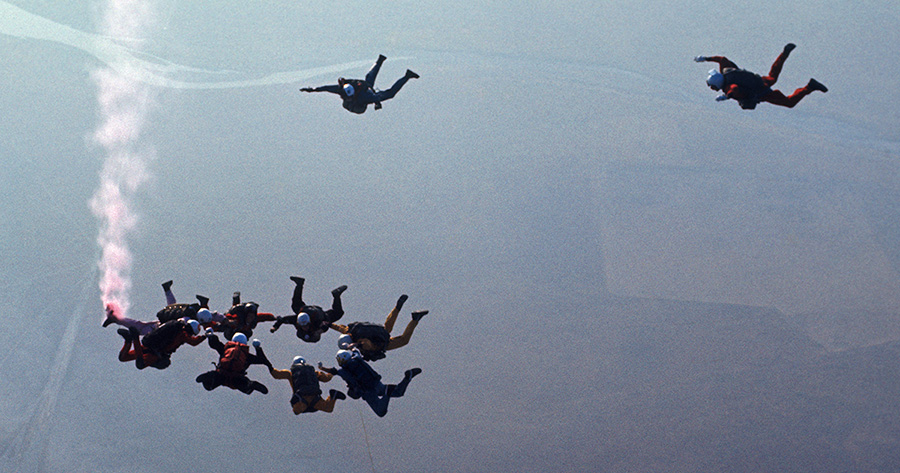
The first all-female 8-way flies over Lake Elsinore in 1969. Photo by Ray Cottingham.
The women were excited and nervous as seven of them boarded the Twin Beech and the eighth (Diane Bird) and photographers Carl Boenish, Ray Cottingham and John Randall climbed into the Howard. The 45-minute ride up to 13,500 feet was tension-filled until Patty Crocitto pulled some lipstick from her jumpsuit and the women applied it for the upcoming jump. (After all, they’d all be on camera!) Even the Beech pilot, Gus Norberg, got a gaudy pair of lips painted on his cheek.
As the Beech turned onto jump run and the Howard followed in formation, Linda Padgett (with 525 jumps) spotted the load through the Southern California haze. Jean Schultz (88 jumps) was base and wore smoke for ground observers, pulling it as she exited. Everyone followed out the door. In a quick 15 seconds, Laura MacKenzie (651 jumps) grabbed Schultz to make the base-pin hookup. Sheila Bodley Scott (196 jumps) docked third and Ann Gardner (440 jumps) fourth. Bird (174 jumps), coming from the Howard, was fifth to dock. Luena Garrison (279 jumps) and Linda Padgett (525 jumps) entered sixth and seventh, and Crocitto (395 jumps) finished the star as number eight. They broke off just above 3,000 feet (a common breakoff altitude at that time) and landed to cheers from observers on the ground. These women pioneers, wearing awkward equipment with belly-mounted reserves and no formal RW training, had accomplished their goal.
It was nearly a year before it happened again. On July 19, 1970, also at Lake Elsinore, there were enough women jumpers present at the drop zone to add five more—Bonnie Cameron, Sandy Donnelly, jeanni McCombs, Nancy Milts and Donna Wardean—to the list of those who had completed an 8-woman star. Then, on April 8, 1972, the California women again came together at Lake Elsinore to make an even larger formation. Their first jump, from a twin-engine Beech, yielded a 9-woman star. On the very next jump, they built an 11-woman star, adding six names— Pat Davis, Lauren Durva, Bonnie Garberich, Nancy Gruttman, Chrissy Shinn and Robbie Skinner—to the list of those accomplished enough in relative work to link up with at least seven others. Clearly, women’s freefall skills had improved significantly since 1969!
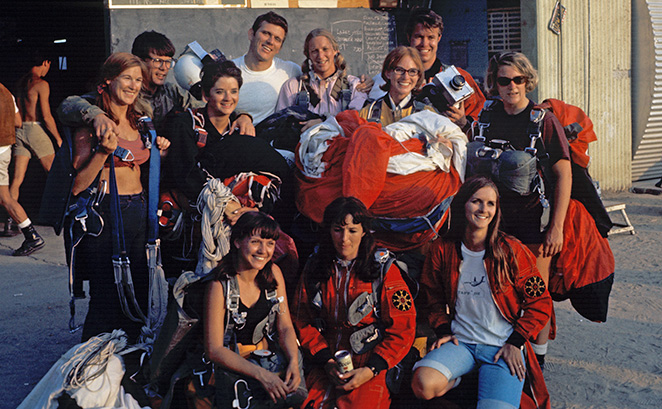
The first WSCR awardees pose for the camera after their milestone jump. Photo by RAy Cottingham.
Enter the WSCRs
No group of women had ever built a formation so large, but at the time there was no official FAI recognition of women’s world records. So, after the 9- and 11-ways, Crocitto and Bill Stage decided to follow the criteria of the Bob Buquor Memorial SCR Awards and establish the Women’s Star Crest Recipient Awards (WSCRs) to formally recognize, document and record this element of women’s skydiving achievement. Skinner designed a popular WSCR patch and the graceful WSCR logo—a woman in blue with long, flowing hair that formed a large bird with outspread wings. Stage created an award card with this logo and began issuing WSCR numbers, starting with those on the 1969 star, in order of entry. That numbering sequence has been preserved throughout the years.
The rules for earning a WSCR are simple: No linked exits; individual entry into the formation, an inward-facing star; hold it for 5 seconds.
On September 3, 1973, once again at Lake Elsinore, men got the opportunity to earn their WSCRs by docking ninth or later on an 8-woman star. The star had to be flying for at least five seconds before a man docked, to prove that it was solid and stable, not just a momentary formation in the process of falling apart or collapsing. Tony DeRosa, Stage and Chuck Wickliffe were the vanguard for the more than 550 men who have since earned WSCRs (many of whom were the formations’ photographers). This addition brought new excitement to the award program, giving women a chance to exhibit their skills as part of the requirement for the men’s participation. As many men have discovered, docking on an all-woman star—which tends to be floaty—can require a great deal of skill and patience.
Soon, the WSCR awards (then earned by 20 women and three men) spread beyond California to the East Coast. On November 25, 1973, 11 women completed a WSCR at Zephyrhills, Florida, during the annual Thanksgiving Turkey Meet “10-man” speed star competition. The first all-female large star built outside of California added 10 new WSCR awardees to the roster: Sally Cain, Mary Donnan, Donna Huminsky, Kristina Juusela, Ruth Lanier, Anita Kay Paul, Marie Splane, Fran Strimenos, Helen Tyson and Jan Works.
Finally, Official Recognition!
In 1974, the FAI began recognizing women’s formation skydiving achievements with official world records. The first women’s large-formation world record was the 16-woman star built by Charmian Cliff, Karen Collett, Pat Davis, Helen Fraser, Nancy Gruttman , Betty Hawkins, Linda Heath, Mary Holdredge, Ruth Lanier, Dianne Marsh, Rolayne Mattsson, jeanni McCombs, Pat Pitcher, Donna Wardean, Patty Wickliffe and Debbie Zweifel on November 27, at Casa Grande, Arizona. The women were from seven states: Arizona, California, Colorado, Florida, Hawaii, Utah and Washington.
Wickliffe, the organizer, wrote in the April 1975 Parachutist that the effort began with “31 women grouped together at Casa Grande, Arizona, over Thanksgiving weekend with the sole purpose of setting the first ‘official’ World Record for the largest All-Girl Star.” She had invited 32 women to the event, filling 22 seats on the Lodestar based on their experience, ability and currency in relative work. Sixteen women made it into the formation. (At that time, records were set by the highest number in the formation and didn’t require 100% of the participants to get in.)
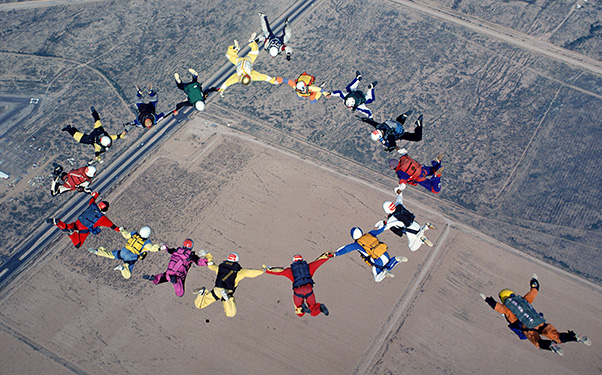
The first women’s large-formation record recognized by the FAI, a 16-way, flies over Casa Grande, Arizona. Photo by Ray Cottingham.
Lorrie Young, the only female FAI Judge in the USA, officiated. USPA Executive Director Norman Heaton spent hours working with Young and Wickliffe to help make sure they complied with all the FAI requirements. Ray Cottingham and M. Anderson Jenkins (the “Godflicker”) provided photographic verification of the accomplishment. It was the largest undertaking in women’s skydiving history at that point and the first to receive formal recognition.
Two years later, 19 women built the largest WSCR-qualifying, FAI World Record star at the USPA Nationals in Tahlequah, Oklahoma. Gruttman organized it and The National Enquirer entirely sponsored all 10 attempts for 24 skydivers and three photographers. The record jumps didn’t cost the women a single cent! The 19-woman star remains the Women’s Oklahoma State Record for Largest Formation Skydive.
Comeback
The WSCR program continued thriving throughout the 1970s and 1980s under Stage’s administration, but began languishing in the 1990s. Between 1993-2010, there were only 12 WSCR numbers awarded, stopping at WSCR #1278. That’s when Nancy Gruttman-Tyler (née Gruttman) took over as program administrator. She was determined to rejuvenate the WSCRs and see them continue to thrive. As part of this effort, she contacted Chazi Rutz, part of the Working Girls group that was putting together Skydive Arizona in Eloy’s first Sisters in Skydiving (a USPA program designed to encourage women’s participation in the sport) event. Rutz was excited to promote the WSCRs at the SIS boogie and on January 29, 2012, she earned her own WSCR along with Erin Kruth, Amanda Kublik, Stephanie LuKach, Karen McCoy, LeAnne Schwab, Shavon Simpson and Lori Zito. It had been nearly 20 years since eight women who had never gotten a WSCR before qualified on one jump!
The WSCR program has been a part of each Skydive Arizona SIS event since. Every year, attendees—many of whom don’t know about the WSCRs—gain enormous enthusiasm to participate in this historic program. At the January 2024 SIS event, load organizer Carol Jones presented eight ladies with their WSCR patches and numbered cards (the most recent being WSCR #1720). One new awardee told Jones that it was the highlight of the boogie for her.
Many other drop zones also promote the WSCR program at their SIS events. Since its inception, the Chicks Rock Boogie at Skydive Elsinore has promoted the WSCRs with help from RW pioneers Sandra Doyle Drahman (WSCR #74) and Chris Deli-Schilpp (WSCR #339). Skydive Perris has also supported women’s world record events and WSCR jumps with the knowledgeable assistance of Donna Wardean Dann (WSCR #11) and Jan Works (WSCR #38) for several years. Gruttman-Tyler travels to DZs across the country frequently to encourage novice women skydivers, judge state records and participate in WSCR skydives.
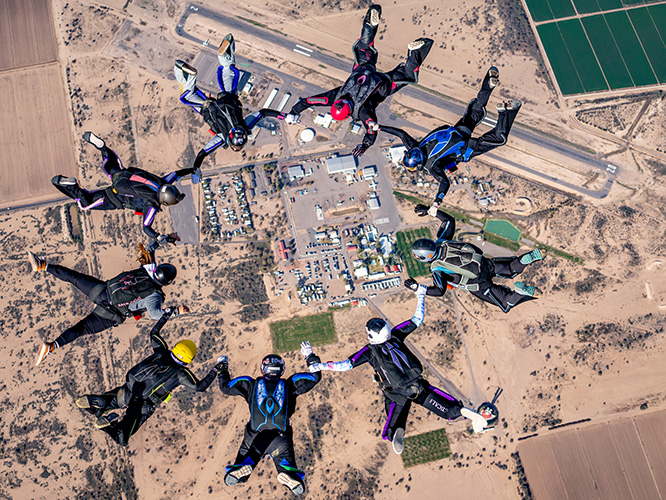
At the 2024 Sisters in Skydiving Boogie at Skydive Arizona in Eloy, the WSCR tradition continues. Photo by Alex Swindle.
There are few awards that a skydiver can earn with fewer than 200 jumps. The WSCRs are an opportunity for inexperienced skydivers, female and male, to jump with highly skilled women. Many times, senior women skydivers “pay it forward” by mentoring inexperienced jumpers and helping them earn their awards. The WSCR award program provides the perfect opportunity for someone with low jump numbers to skydive with those who have thousands of jumps.
Over the years, some of those early WSCR holders began earning skydiving records through the Parachutists Over Phorty Society (POPS) and its sub-group, Skydivers Over Sixty (SOS). Women’s records through POPS are called Tiny Broadwick Memorial records, honoring the first person—a woman—to deploy a parachute manually. In 2015, Gruttman-Tyler was on the SOS TBM World Record 16-way, 40 years after being on the first 16-woman WSCR formation. Today, Gruttman-Tyler, with assistance from Jones, is working on compiling data from the early SOS TBM records to create a sub-group of the WSCR program for Women Skydivers Over Sixty (WSOS WSCRs).
Another sub-group of the WSCR is Night WSCRs. The first NWSCR was on October 22, 1977, at Lake Elsinore. It was an 11-woman star. To date, only 68 NWSCR numbers have been issued.
Any eight or more women can put together a WSCR jump, there is not a requirement for the organizer to have a WSCR number. In fact, any woman who has participated in an official world, national or state women’s record qualifies automatically and can apply for a WSCR award. Forms and rules are available at wscr.org.
Those with questions or who would like to put together a WSCR jump at their drop zone can email at Nancy Gruttman-Tyler at gruttmantyler@gmail.com or Carol Jones at carold17918@protonmail.com.
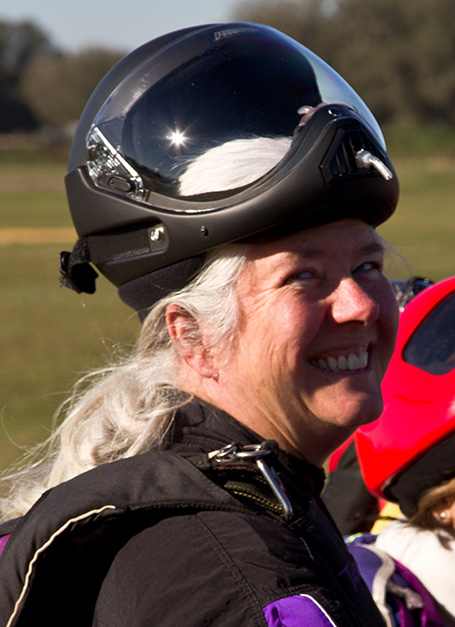 About the Author
About the Author
Carol Jones, D-17918, has been skydiving for more than 30 years. She received WSCR #1311 participating in the Jump for the Cause Women’s World Record 151-way. Jones formerly owned and operated DZs with her husband, Bill. She is now retired and enjoys summers in Wyoming and winters in Arizona. Carol is a load organizer for the annual SIS event at Skydive Arizona, where she helps other women receive their WSCR awards.